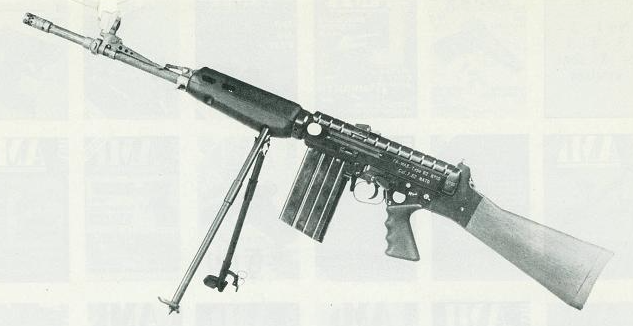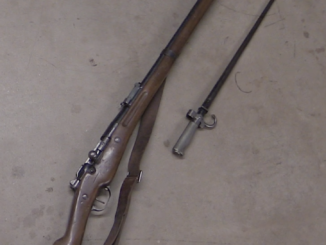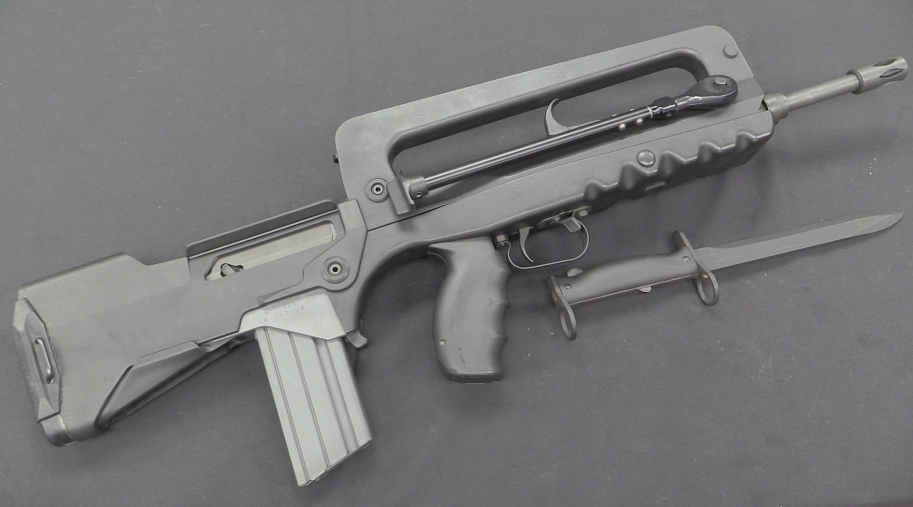Darne was a French gunmaker best known for sporting shotguns, but they entered the military arms field during World War One. The Lewis Gun was one of the best Entente aircraft guns, and Darne put a licensed copy into production in 1915, making a bit more than 3,000 of them by the end of the war. During this time they also developed their own machine gun design, which was ordered by the French military, but cancelled with the Armistice in November 1918. After further refinement, Darne’s design was formally adopted by the French Air Force in the 1920s. About 11,000 were made in total, about half for France and the other half for a variety of foreign clients including Brazil, Turkey, Italy, Yugoslavia, and Spain.
Darne hoped to market its machine gun design as more than just an aircraft armament. In its catalog, the same basic mechanism was offered as a light infantry gun, fortification gun, heavy machine gun, dual-mount antiaircraft gun, and vehicular gun. While some countries tested these other configurations, it was only the aircraft pattern that we are looking at today which was actually purchased in substantial quantities by anyone. Darne was just a bit too late to make substantial sales during World War One, and their gun was being eclipsed by better designs (like Browning aircraft guns) by the European rearmament of the 1930s.
Thanks to the Cody Firearms Museum for allowing me access to film this rare and interesting machine gun!




The Spanish Army Air Corps used the Darne Machine gun as observer MG. It was not very popular. Possibly too complex and prone to failures.
I heard that the high rate of fire, combined with purported unreliability when shoved into field conditions, is what killed the Darne’s potential popularity in roles unrelated to aircraft. And we know that rifle bullets aren’t exactly the best for air-to-air shooting against more advanced planes. Unless you’re aiming for the enemy pilot specifically, rifle bullets won’t do much vital damage to planes. I could be wrong.
At around WWI time they did. Whatever was hit went into pieces.
Against relatively slow planes made of wood and fabric, rifle bullets were more than enough. But once planes get faster and tougher, the rifle-caliber machine gun hits its limit.
“(…)rifle-caliber machine gun hits its limit(…)”
If 8 mm or ·303 is not enough for you then take bigger version:
https://www.smallarmsreview.com/display.article.cfm?idarticles=1299
The manufacturer also proposed a “big bore” machine gun (11 to 15 mm), able to be furnished in normal or synchronized version. The rate of fire was approximately 900 rounds per minute. Weight 22 to 33 lbs (10 to 15 kg).
“(…)we know that rifle bullets aren’t exactly the best for air-to-air shooting against more advanced planes. Unless you’re aiming for the enemy pilot specifically, rifle bullets won’t do much vital damage to planes.(…)”
Armée de l’air does not seems to be compliant with that way of thinking in most of inter-war period, taking in account for example that:
Nieuport-Delage NiD-42 which few hundreds were produced were armed with 3 rifle-caliber machine guns.
Dewoitine D 500 was also armed solely with rifle-caliber machine guns http://www.aviastar.org/air/france/dewoitine_d-500.php
MAC 1934 rifle-caliber machine gun was adopted around 1934
Rifle-caliber machine guns were pretty much the standard until about 1940 in all countries. The French were an early adopter of the 20mm Hispano cannon for example in the MS. 406 fighter. The Germans had the 20m Oerlikons in the Bf 109E, but earlier Bf 109 variants had just rifle-caliber guns. Interestingly the first production model of the Fw 190A in 1941 was still armed with just four rifle-caliber weapons.
The Soviets made limited production fighter-bomber versions of the I-16 with two 20mm ShVAK cannons, but the standard fighter versions were still armed with rifle-caliber ShKAS machine guns until 1940, because the cannons reduced performance too much. The USAAC and US Navy were early adopters of the heavy machine gun with several models equipped with mixed rifle-caliber and .50 caliber guns by 1940. Likewise the Italians had 12.7mm machine guns from 1940 onwards. On the other hand the USAF was an extremely late adopter of the 20mm or larger cannon (with few exceptions such the P-38 and P-39); air combat in Korea finally convinced them to make the switch from heavy MGs to cannons. US Navy made the switch much earlier soon after WW2.
All British aircraft were armed with rifle caliber machine guns during WW2.
Not quite. Aircraft started with .303 Brownings but it was known even very early in the war that for fighter aircraft this would be inadequate, even with the weight of fire a 3 second burst from 8 guns could give. The main problem was adapting the Hispanic Suiza cannon from metric to imperial tooling and strengthening fighters to take the added recoil. By 1941 fighters had either mixed 20mm cannon and .303mg armament or all cannon (Hurricane IIc, Whirlwind,Typhoon). 4x 20mm was standard by wars end. Power turrets in bombers got a worse deal with .05 Browning turrets only in 1945 unless they lend-lease US types. Most British turrets used the .303 till wars end though.
Worse deal with fifty calibers? Tell that to the Luftwaffe and Japanese attacking
U.S. bombers.
He probably meant that British bomber turrets got a worse deal than fighters, because they received .50 cal Brownings only in 1945 (and not earlier).
“All British aircraft were armed with rifle caliber machine guns during WW2.”
No. Westland Whirlwind was armed solely with 20 mm caliber and created in response to Specification F.37/35 i.e. dating back to 1935.
http://www.aviastar.org/air/england/west_whirlwind.php
The Typhoon has already been mentioned, but of course also the later fighter models Tempest and Meteor also had uniform 20mm cannon armament. Even the Spitfire finally transitioned to 20mm only with the Mk 21.
Some Spits had Fifties in place of .303 when cannon-armed.
Specifically the Spitfire Mk XIV had two .50 cals in addition to two 20mm Hispano cannons, and no .303s. The RAF had been aware that the .303s were nearly useless for air combat for some time, but prior to the Mk XIV no satisfactory solution to replace them in the thin wing of the Spitfire could not be found.
Initially the Spitfire was armed with eight Browning .303 MG in the wings, but later the British made Hispano-Suiza 20 mm cannon under license and mounted in the Spitfire and other planes. So, from 1940 onwards the armament of Spitfires was changed to two 20 mm Hispano and four .303 Browning.
A very interesting machine gun.
But in aviation, he never got a chance.
And it’s not even the caliber.
Such a feeding system cannot work reliably during overloads arising from aircraft maneuvering. It is still normal for slow-moving bookcases of the First World War, but not for the speeds of new aircraft.
In addition, the rate of fire for aviation is too small, and it is impossible to increase it.
Probably, if the author had guessed to do this for a box magazine and adapt for use as an LMG, something worthy could have turned out.
“(…)box magazine(…)”
There existed such feed Darne weapon, however it was Automatic Rifle not LMG
https://www.smallarmsreview.com/display.article.cfm?idarticles=1299 describes it as follows
Automatic rifle with 20-, 25- or 30-round magazine. At the choice of the customer, the weapon could be provided with a selector allowing delivery of two or three rates of fire: from 100 shots per minute with a regulator, up to 800 shots per minute for anti-aircraft defence. Equipped with a stock and a monopod, it weighed only 15.2 lbs (6.900 kg).
Now this is a controlled feed. on every step the cartridge is being held by some little lever, clamp or similar. But as Ian and all the others have said already, to fiddly and complex and probabaly not good at withstanding g-loads. In the field of battle this contraption probabaly jams immediately upon coming close to dirt.
So as Carlos Villarroel said further up, the Spansh baught a few of these. Makes me wonder if the italians with their intricate clockwork machine guns may have thought of the Darne MG?
Would Iain say “it works with holy spirit”, would it be enough for You? 😉
Take a look at the diagram.
The next cartridge just lies on two forks. Turn the system upside down, or shake it well, or just increase the speed of the moving group…
Everything goes to hell.
http://sam40.fr/forces-et-faiblesses-des-armements-aeriens-mitrailleuses-legeres-et-canons-de-20-mm/
“jams immediately upon coming close to dirt. ”
If interwar Polish point-of-view at this weapon is interesting for you:
Cartridge between exiting belt and entering chamber does execute complicated set of movements. When cartridge fail to follow planned movements it become stuck, one of arm is pushing middle of case causing bent in case. Clearing of this malfunction is very hard. Low immunity against dirt. Ill-suited for infantry use. Certain countries bought these machine gun for aviation usage where more time might be consumed for conservation. This weapon is relatively cheap, but so far it is unknown if fit for aviation use.
Original: see page 708 of following pdf: http://zbrojownia.cbw.wp.mil.pl:8080/Content/1111/SZ_24073_INW_62939.pdf
Interestingly it also mention that there existed water-cooled version and states when there was not water it weighted 11,600 kg and when it was full it weighted 13,000 kg
Taking away all the little fiddly bits, it looks kind of like a PKM and/or upside down AK. I wonder if Kalashnikov ever saw one.
Should have seen. That’s the only way it worked.
This was (and is) the Soviet design system.
Everything that was possible was bought or stolen in the west. And then they took pieces of it and tried to mold something viable and suitable for primitive technologies.
Sometimes it worked. But usually it turned out to be another Frankenstein, which cannot be sold or thrown away.
Han Ion ever received heat for putting a weapon back together WRONG???